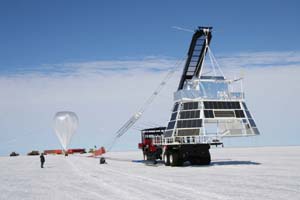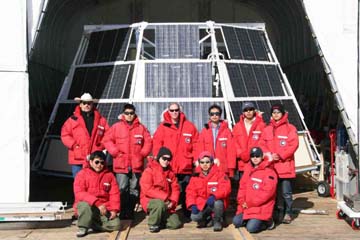Imagine the Universe News - 29 December 2004
Scientific Balloon Circles South Pole on Search for Antimatter
| 29 December 2004 |

|
|
BESS-Polar shortly before its
launch on Dec 13, 2004 from Antarctica. (PHOTO CREDIT: NASA) |
A group of Japanese and American scientists bundled in thick orange jackets, hats, boots and gloves have ventured down to Antarctica on a search for antimatter. With their high-altitude balloon-borne instrument, they are in an exotic land to learn about exotic particles.
The instrument, called BESS-Polar, launched successfully on December 13 from McMurdo Station, Antarctica beneath a 40-million-cubic-foot scientific balloon as big as a football field. It remained aloft until December 21 at an average altitude of 24 miles (39 kilometers), a near-space environment above 99% of the atmosphere. The instrument traveled nearly once around the South Pole.
The team seeks to understand the origin of cosmic antimatter and to find evidence for the existence of Hawking radiation from "evaporating" black holes, a theory proposed by Prof. Stephen Hawking of Cambridge University in England. The long flight for BESS-Polar was intended to maximize the possibility of finding this antimatter predicted by Hawking.
"Our earlier, shorter flights from northern Canada have provided hints of the signature of Hawking radiation," said Principal Investigator Prof. Akira Yamamoto of Japan's High Energy Accelerator Research Organization (KEK). "With a longer flight and a greater 'harvest' of antiprotons, we might be able to show that Prof. Hawking is right."
BESS-Polar is collaboration among scientists at KEK, the University of Tokyo, Kobe University, and the Institute of Space and Astronautical Science of the Japan Aerospace Exploration Agency, along with NASA and the University of Maryland, College Park. BESS stands for Balloon-borne Experiment with Superconducting Spectrometer.

|
|
The BESS-Polar team in Antarctica (PHOTO CREDIT: NASA) |
Antimatter is made up of particles with equal but opposite characteristics of the particles of matter we interact with everyday. For example, protons have a positive charge, but antiprotons have a negative charge. Antiprotons created in space bombard the Earth in the form of cosmic rays, which are elementary particles traveling at near light speed. When matter and antimatter collide, they annihilate, creating pure energy and no "ash".
The most basic form of the Big Bang theory predicts that equal amounts of matter and antimatter were created. If so, all matter would have annihilated and the Universe would be empty. Somehow, matter dominated antimatter in the initial moments following the Big Bang. One of the BESS-Polar project's goals is to see if there is any evidence of antimatter domains left over from the Big Bang.
Another of BESS-Polar's goals is to search for Hawking radiation. Just outside the event horizon of a black hole, virtual particles may be created for a very short amount of time from quantum fluctuations in the vacuum of space. These particles are created in matter-antimatter pairs. If this occurs close to the event horizon, one of the members of the pair can fall into the black hole, while the other remains outside. This produces a "radiation" from the black hole that Hawking predicted.
The study of lower-energy antiproton particles is particularly exciting, Yamamoto said, because they might have been created by "evaporating" black holes which are emitting Hawking radiation. This type of radiation has not yet been seen in nature. This would be from primordial, microscopic black holes created just after the Big Bang. Finding antiproton particles in an abundance and energy range predicted by theory would serve as compelling evidence.
"The northern and southern polar regions are the best places to collect low-energy antiprotons," said U.S. Principal Investigator Dr. John Mitchell of NASA Goddard Space Flight Center, at McMurdo Station for the flight. "The Earth's magnetic field protects us from antiprotons and other cosmic-ray particles from space. The magnetic field funnels charged particles toward the Earth's poles, so the concentration of lower-energy cosmic rays entering into the Earth's atmosphere there is greater."
This is the first flight for BESS-Polar. Scientists have flown an earlier version called BESS for daylong flights in northern Canada once a year nearly every year from 1993 to 2002. That instrument collected millions of cosmic rays and a few thousand low-energy antiprotons. But more are needed for better analysis.
"We journeyed to the bottom of the world so that we could get a nice, long flight," said Project Manager Prof. Tetsuya Yoshida of KEK. "Longer flights mean better statistics." In addition, a longer flight increases the ability to get to lower energy antiprotons (which helps detect the Hawking radiation).
Constant daylight in Antarctica means no day-to-night temperature fluctuations on the balloon craft, which helps the balloon stay at a constant altitude for longer. The BESS-Polar team hopes to collect enough antiprotons to characterize their absolute intensity (number per square meter per second per solid angle) among other the cosmic rays in terms of energy.
The Wallops Flight Facility, Wallops Island, Va., manages the Scientific Balloon Program for NASA. The National Scientific Balloon Facility located in Palestine, Texas, manages NASA's balloon launch operations. The National Science Foundation Office of Polar Programs operates McMurdo Station.
For more information and images from Antarctica, refer to

